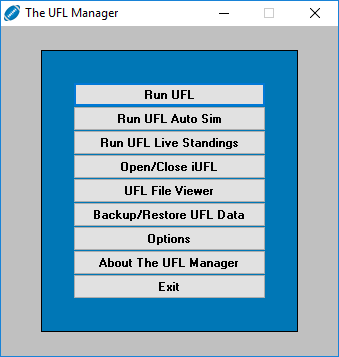
The UFL Manager Manual

Introduction
The UFL Manager is an application that works in conjunction with UFL to provide some additional functionality. This manual will explain all of The UFL Manager's features, button by button.
The History Of The UFL Manager
(Screenshots of The UFL Traveler and The UFL Manager 1.0. Click here to see a complete visual version history.)
In the UFL for DOS days, I used to create a Windows shortcut folder which would contain a shortcut to UFL, shortcuts to championship results and championship rankings files, a shortcut to a team coaching histories list, and shortcuts to all of my league's season standings files. This shortcut folder provided some additional functionality to UFL that The UFL Manager still provides today.
As my interest in UFL grew, I developed the need to transfer my UFL data to and from different computers. Floppy disks were the only media suitable for the purpose at that time, so I needed a utility to backup/restore my UFL data to/from a disk for me. Thus, the first add-on for UFL was born: The UFL Traveler. The first version of The UFL Traveler was a DOS program that was written in QBasic. It had 2 functions: Copy To Disk and Copy From Disk. These functions would launch the DOS version of PKZIP/PKUNZIP and would either ZIP up UFL data to a floppy disk or extract the ZIP file from a floppy disk. As I advanced deeper and deeper into my UFL leagues, my shortcut folder began to grow cluttered with all of the shortcuts to standings files that I had created. So, using my limited Visual Basic 6.0 knowledge, I created a small program that allowed me the view championship results, championship rankings, team coaching histories, and season standings through one single application. This eliminated the need for a folder full of shortcuts, and The UFL Manager was born.
Various changes and improvements have been made to The UFL Manager throughout the years: Version 2 added Windows XP theme support. Version 3 added the UFL League Manager, and included the classic boat icon (The boat icon was chosen because it was the icon that I used to assign to my shortcut to the DOS version of UFL). The UFL Traveler was also updated to allow the back up/restoration of UFL data to locations other than a floppy disk, such as thumb drives, network drives, CD-RW discs, etc. Version 4 was the first version made for the Windows version of UFL. It removed the season standings viewer (UFL now has a season standings viewer built-in) and added the Customize UFL Manager option to hide unused features. Version 5 added a UFL-style color scheme, new UFL icon and a Windows-only version of The UFL Traveler which did not depend on a command line executable. Version 6 added UFL Auto Sim, UFL Live Standings and many other improvements. Version 7 added the iUFL panel and some additional options. You can read about all of its current features below.
1. Run UFL
This button launches the UFL game.
2. Run UFL Auto Sim
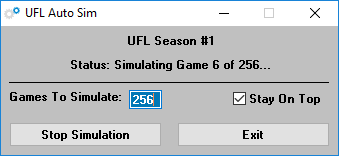
This button launches UFL Auto Sim. UFL Auto Sim allows you to simulate large batches of Computer vs. Computer UFL games. You can simulate an entire season (including the postseason) or just the games that occur between human coached games. Here are some instructions and details about this tool:
UFL must be open to the Season Game Window before you can simulate any games. A screenshot of this window is shown below.
The Number Of Games To Simulate field is the number of games that will be simulated. You can simulate an entire season (including the postseason) in one sweep. So to simulate a complete 32-team league season, you would specify 267 games (256 regular season + 11 postseason games). For reference, here are the number of regular and postseason games in each size league: 8 teams/57 games (56 + 1), 16 teams/131 games (128 + 3) , 24 teams/201 games (192 + 9), 30 teams/251 games (240 + 11), 32 teams/267 games (256 + 11).
When a simulation is in progress, the Status caption will display the simulation's current position. (For example: "Simulating Game 96 of 267").
You may press the Stop Simulation button to stop a simulation at any time. Note that it is not possible to interrupt a game in progress; the simulation will stop after the current game.
The Stay On Top option will force the UFL Auto Sim window to always remain on top of other windows. This is useful for keeping track of the simulation's progress.
You are free to use other programs while a simulation is in progress, however, UFL will always steal back its window focus when it begins the next game in the simulation cycle. This can sometimes cause certain keystrokes to interrupt the simulation process if you are typing when UFL steals its focus back. If that happens, go to the UFL window and attempt to advance to the Season Game Window and click the Play Next Game button. The simulation process should resume automatically, but if it does not, you will have to exit UFL Auto Sim, launch Task Manager and end the OLDUFL.EXE process, and then restart UFL and UFL Auto Sim.
If you accidentally click or press enter on UFL's Change Control button during an in-progress simulation, the current game will halt, and you will need to exit UFL Auto Sim, launch Task Manager and end the OLDUFL.EXE process, and then restart UFL and UFL Auto Sim. UFL's Change Control button is hidden by default for this reason.
UFL Season Game Window:
3. Run UFL Live Standings
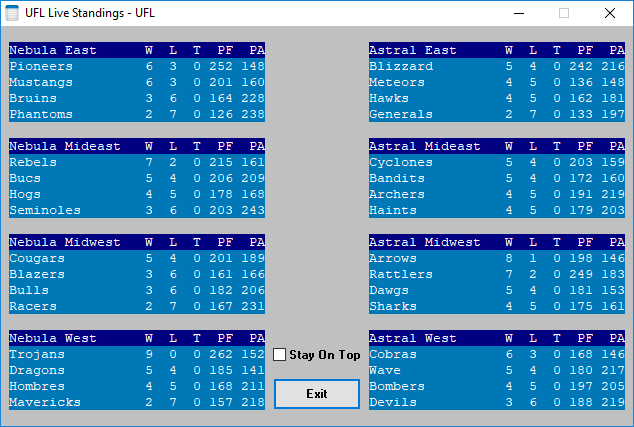
This button launches UFL Live Standings. UFL Live Standings allows you to view the standings for your active UFL league in a window outside of UFL. The standings are automatically refreshed every 15 seconds and provide a quick and easy to view your league's standings without navigating to UFL's Show Standings window. Here are a couple of details about this feature:
The Stay On Top option will force the UFL Live Standings window to always remain on top of other windows. This is a great way to keep track of your league while a simulation is in progress.
UFL Live Standings does not have a standard title bar to maximize screen space. You may click and drag anywhere in the grey to move the window or use the buttons in the top right to minimize or close the window.
If you change active leagues while UFL Live Standings is open, it will detect the change and automatically restart itself at the next 15 second interval.
4. Open/Close iUFL

This button will open iUFL if it is closed or close iUFL if it is open. iUFL is a panel with large buttons that can be configured to call offensive/defensive plays, punts, field goals, timeouts, or send an Enter command to advance through game play dialogs. iUFL makes it easier to play UFL on a tablet through a screen sharing application such as Remote Desktop, AnyDesk, or TeamViewer. iUFL's close button on the window is disabled, and there is no Exit button by default. This was done to prevent inadvertently closing the iUFL window while playing on a tablet.
iUFL Customization
iUFL comes with a default layout, but you will surely want to customize it with your favorite plays and preferences. iUFL supports layouts with 12, 14, 16, 18, or 20 buttons. There is no GUI for customizing iUFL. To customize the layout, you will need to edit C:\UFL\LAYOUT.DAT. LAYOUT.DAT contains 41 lines. The first line represents the number of buttons to display, so the only valid entries on the first line are 12, 14, 16, 18, and 20. The remaining 40 lines are the button configurations. Each button configuration uses two lines. The first line is the button type and the second line is the button command. There are 4 types of buttons:
OFFENSE: Offensive button commands can be any valid offensive UFL play call. FG and PU are also valid offensive play calls for kicking field goals and punting.
DEFENSE: Defensive button commands can be any valid defensive UFL play call.
SPECIAL: There are 2 valid special commands: Enter and Exit. Enter will send an Enter command to the UFL game window. There are numerous game dialogs that this will enable you to advance through. The Exit command will create a button that exits the iUFL panel.
TIMEOUT: There are 3 valid timeout commands: Y, N, and H. These commands are used to answer the dialog that inquires about whether to take timeout or to hurry up.This is the what the default LAYOUT.DAT looks like (my comments in parenthesis are not part of the actual file):
12 (the number of buttons to display)
offense (button type)
1221 (button command)
timeout (button type)
Y (button command)
offense
1321
timeout
N
offense
3241
timeout
H
offense
3242
special
Enter
offense
PU
defense
601
offense
FG
defense
605
offense
1221
offense
1221
offense
1221
offense
1221
offense
1221
offense
1221
offense
1221
offense
1221The LAYOUT.DAT file must contain 41 lines, regardless of the amount of buttons you choose to display. If you inadvertently specify an invalid play call, the button will simply not work, but if you make invalid changes to LAYOUT.DAT, iUFL will display an error message and refuse to open. Fortunately, iUFL's layout can easily be reset to its default configuration from The UFL Manager's Options window.
5. UFL File Viewer
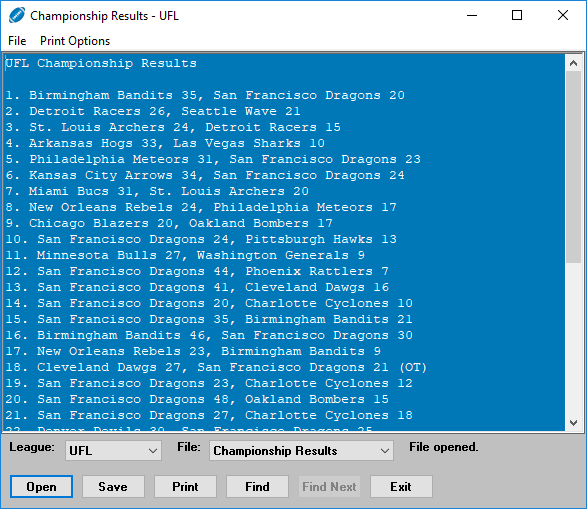
This button launches the UFL File Viewer. The UFL File viewer allows you to view and edit text files that are located in your leagues' Archive sub-folders. You can choose from one of the pre-defined file types or choose Other to open a specific file. The Other selection is useful for viewing UFL .LOG files. (Note that you must input the entire filename including the extension when using the Other selection. For example: WLT-001.LOG). The UFL Manager comes with two pre-defined file types: Championship Results and Championship Rankings. You can remove existing file types or add more by clicking on the Options button on the The UFL Manager main menu.
6. Backup/Restore UFL Data

This button launches Backup/Restore UFL Data. Backup/Restore UFL Data allows you to backup or restore your UFL data to or from another location. This location can be a thumb drive, external hard drive, network drive, or anything else with a drive letter. It also supports UNC network paths. Here is some additional information that you'll need to know about this feature:
Backup/Restore UFL Data only transfers UFL and UFL Manager data. It does not transfer EXEs or static DAT files. UFL and UFL Manager data consists of: all .CHM, .IRC, .IRG, .IRP, .IRS, .LGE, .PLA, .SCH, .TMS, .TRC, .TRG, .TRP, and .TRS files that reside in C:\UFL; all .LGE, .LOG, .PLA, .SCH, .TMS, and .TXT files that reside in your leagues' Archive sub-folders; the LEAGUE.ID1 file; and The UFL Manager's .DAT files.
The "Do not recopy league archive files if they already exist." option speeds up the backup/restore process by not transferring league archive files that already exist in the destination. Please note that this only applies to .LGE, .PLA, .SCH, and .TMS files. .LOG and .TXT files that reside in your leagues' Archive sub-folders will always be transferred.
Backup/Restore UFL Data will always assume that the data in the source path is preferred. For example: if you are backing up your data, the data from C:\UFL will always overwrite data that exists in your Location; and if you are restoring your data, the data from your Location will always overwrite data that exists in C:\UFL.
In addition to backing up/restoring your UFL data, this feature can also be used to synchronize your UFL data with a copy of UFL on another PC. You can use a thumb drive or external hard drive as a go-between, backing up your UFL data on one PC and then restoring it on another. You can also use a network drive or UNC path to directly access another's PC UFL data. For example: \\myotherpc\c$\UFL. Just make sure that both PCs are running the same version of UFL And The UFL Manager before attempting synchronization.
The UFL Manager 7.x cannot restore backups that were made with The UFL Manager 6.x and earlier. Old backups can still be restored, but you will need to manually copy the files from your backup location to C:\UFL.
There is no provision for choosing which leagues are to be transferred. All UFL leagues that are located in C:\UFL will automatically be transferred.
7. Options
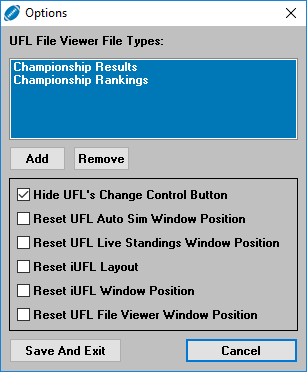
This button launches Options. This is where you can add/remove UFL File Viewer File Types, hide UFL's Change Control button, reset the iUFL layout, and reset window positions if they get lost off-screen. Here are a few things that you need to know about file types:
8. About
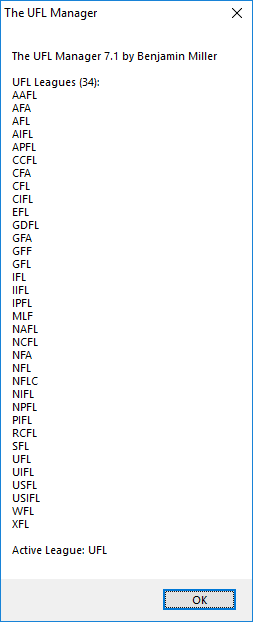
This button displays an about dialog that shows The UFL Manager version number and a list of your UFL leagues. It also shows you which league is currently active.
8. Exit
This button exits The UFL Manager. You won't be using this much!